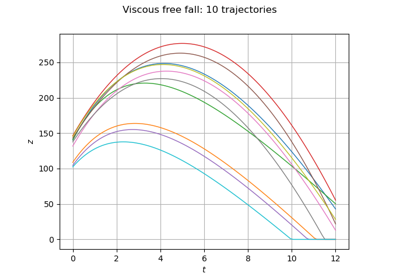PythonPointToFieldFunction¶
- class PythonPointToFieldFunction(inputDim, outputMesh, outputDim, func=None)¶
Override PointToFieldFunction from Python.
- Parameters:
Examples
>>> import openturns as ot >>> mesh = ot.RegularGrid(0.0, 0.1, 11) >>> def myPyFunc(X): ... size = 11 ... Y = [ot.Point(X)*i for i in range(size)] ... return Y >>> inputDim = 2 >>> outputDim = 2 >>> myFunc = ot.PythonPointToFieldFunction(inputDim, mesh, outputDim, myPyFunc)
Evaluation on a vector:
>>> Yfield = myFunc([1.1, 2.2])
Methods
Get the number of calls of the function.
Accessor to the object's name.
getId()Accessor to the object's id.
Accessor to the underlying implementation.
Get the description of the input vector.
Get the dimension of the input vector.
getMarginal(*args)Get the marginal(s) at given indice(s).
getName()Accessor to the object's name.
Get the description of the output field values.
Get the dimension of the output field values.
Get the output mesh.
setInputDescription(inputDescription)Set the description of the input vector.
setName(name)Accessor to the object's name.
setOutputDescription(outputDescription)Set the description of the output field values.
- __init__(*args)¶
- getCallsNumber()¶
Get the number of calls of the function.
- Returns:
- callsNumberint
Counts the number of times the function has been called since its creation.
- getClassName()¶
Accessor to the object’s name.
- Returns:
- class_namestr
The object class name (object.__class__.__name__).
- getId()¶
Accessor to the object’s id.
- Returns:
- idint
Internal unique identifier.
- getImplementation()¶
Accessor to the underlying implementation.
- Returns:
- implImplementation
A copy of the underlying implementation object.
- getInputDescription()¶
Get the description of the input vector.
- Returns:
- inputDescription
Description Description of the input vector.
- inputDescription
- getInputDimension()¶
Get the dimension of the input vector.
- Returns:
- dint
Dimension
of the input vector.
- getMarginal(*args)¶
Get the marginal(s) at given indice(s).
- Parameters:
- iint or list of ints,
Indice(s) of the marginal(s) to be extracted.
- iint or list of ints,
- Returns:
- function
PointToFieldFunction The initial function restricted to the concerned marginal(s) at the indice(s)
.
- function
- getName()¶
Accessor to the object’s name.
- Returns:
- namestr
The name of the object.
- getOutputDescription()¶
Get the description of the output field values.
- Returns:
- outputDescription
Description Description of the output field values.
- outputDescription
- getOutputDimension()¶
Get the dimension of the output field values.
- Returns:
- d’int
Dimension
of the output field values.
- setInputDescription(inputDescription)¶
Set the description of the input vector.
- Parameters:
- inputDescriptionsequence of str
Description of the input vector.
- setName(name)¶
Accessor to the object’s name.
- Parameters:
- namestr
The name of the object.
- setOutputDescription(outputDescription)¶
Set the description of the output field values.
- Parameters:
- outputDescriptionsequence of str
Description of the output field values.
Examples using the class¶

Define a function with a field output: the viscous free fall example
 OpenTURNS
OpenTURNS